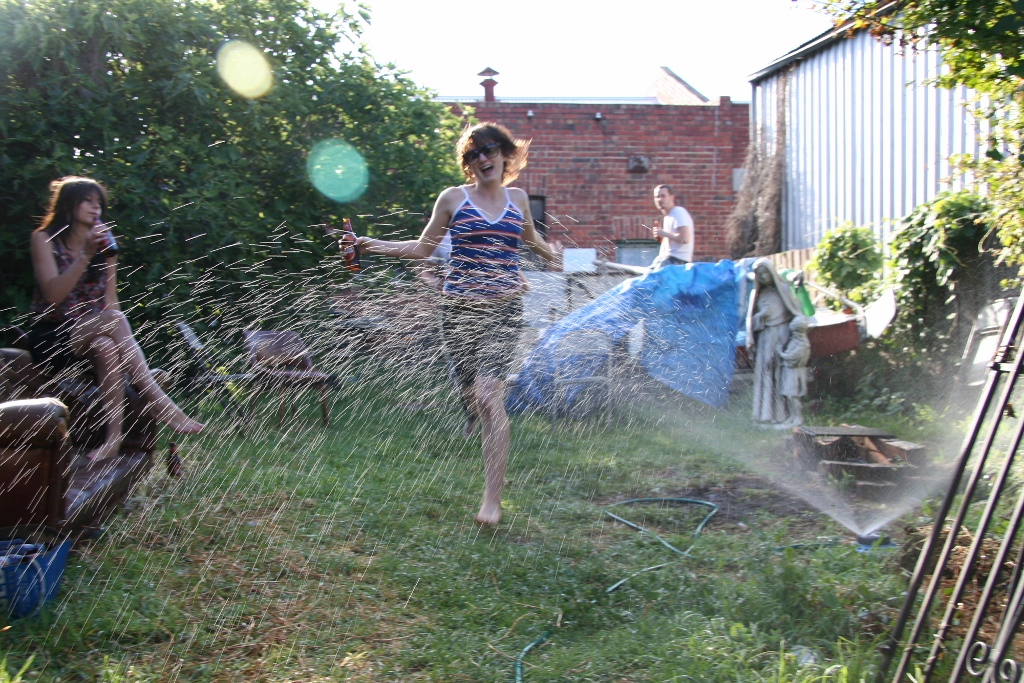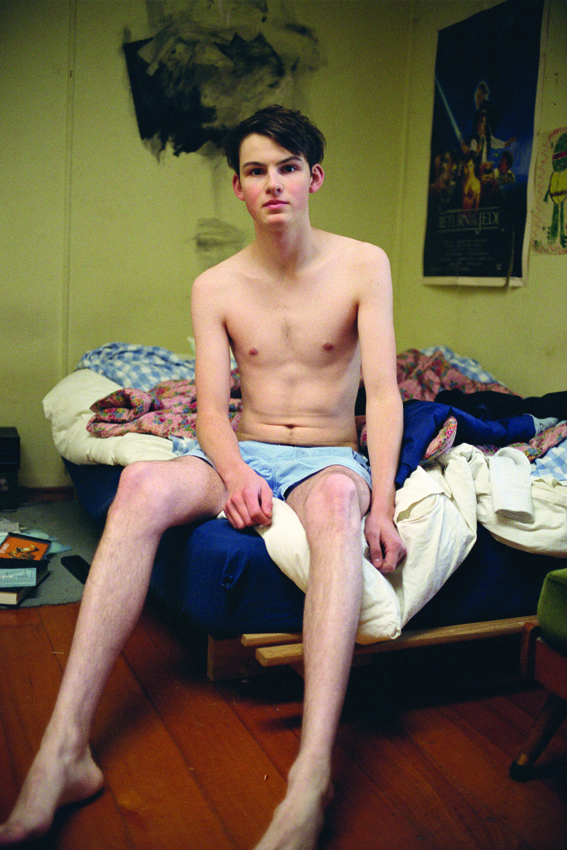Fashioning Sexuality and Gender with Lyndal Walker

Lyndal Walker addresses the fleeting moment in works that challenge perceptions of gender, identity construction and power. Photography has been a strong current in Walker’s work, however it is just as likely that these complex issues might be explored through baking a cake with The Hotham Street Ladies, all the while done so with a nod to history and an acute consciousness of the nuances of image creation and the reading of meaning. Art World Women spoke with Lyndal Walker about sexuality, gender and her evolving artistic process.
image above: Lyndal Walker, Remember the Fountain of Youth?, 2006, Type C photograph, 34 x 50cm

AWW: Your work seems to explore issues which are inherent to photography itself yet also seem core to the human experience, the process of seeing and perception along with how we filter, frame and construct our experience of the world. How do you see that the medium of photography has influenced you choices of subject matter and the ideas you explore through your work?
LW: One of the main attractions of photography to me has been its relationship to time, which is one of my most enduring themes. In a work like ‘Remember the fountain of youth’, I’m interested in capturing a fleeting moment – in a day, in people’s lives and in the life of a city. That being said, I’ve recently made efforts to escape photography. It has become limiting for me and the aspects of time I wanted to explore were much more about accepting the fleetingness – rather than holding on to it. Documenting things has come to feel very morbid and quite neurotic. Also as people increasingly take photos of everything, all the time, they are also increasingly distant from actual experience. The photographer is always the outsider.
AWW: Gender and sexuality are recurring themes in your work. You seem to have a way of turning our expectations back on the viewer. Your work becomes like a mirror reflecting back to us the awkwardness of our assumptions based on our perceptions of gender such as in your work “Stay Young” a series of images which “seeks to capture the fleeting beauty of men in their early twenties”. What is important to you about these themes?
LW: I’m always interested in experimenting with our assumptions about gender and sexuality. In Stay Young I explored vulnerability through photographing men but it is usually women who are used to express this state. Of course we’re all vulnerable, in so many ways, no matter our gender. Gender and sexuality are in flux, which is very exciting. So many changes have taken place over the last fifty years and so many more are still to take place as we reach more balance between the genders in society but also in ourselves as individuals. It’s a fascinating area to explore and document and a very unusual point in history for the development of expressions of gender and sexuality.
AWW: Women are frequently represented as passive and as object in traditional and contemporary mainstream imagery. You reference “paintings from the 18th and 19th century that represented women dressing” as inspiration for your series ‘La Toilette d’une Femme‘ (2010). Although the voyeur is present in your works, as it was in those earlier paintings, the roles have changed significantly. What are these shifts in roles and representations of the “model”, “artist/photographer” and “voyeur” in your view?
LW: I think that there’s a lot more to change in terms of the roles of model, artist/photographer and voyeur. Despite there being so many more women making photographs, women are so often represented as passive objects. Images are at the heart of our culture and it often surprises me how little people understand about the making of them and the power relations involved. When I made ‘Remake Remodel’ with Dani Hakim, we were thinking a lot about models and the way their role in art and photography is often really devalued. We made images of the muses as caryatids, which are representations of the human form that look like they are holding up buildings. The work was collaged from images of models in fashion magazines and from art.

AWW: An awkward naturalness inhabits your work. How do you achieve this? Do you direct your subjects or are you more akin to the reporter/photographer?
LW: The way I work with models and also the environments I photograph is somewhere between direction and reportage. I let the model create the poses as much as possible because, of course our bodies and how we use them are an important way we express ourselves. However I find if you don’t direct people a bit, then there are very, very awkward and I like them to feel comfortable.
AWW: Some art aims to be “timeless and ageless”. In contrast, your work seems very much of the moment, filled with the minutiae which reinforce a sense of documentary realism. How do you make your choices about the “context” of your subjects, in particular to a creating a sense of time? Is this something you consider?
LW: One of my very early motivations was to reject any notion of timelessness and make work that would deliberately date and this is how I first started making work about fashion. That interest has morphed and developed but expressing various aspects of time directs the context and subjects for my work. For example, I often include items that show the effects of time like old furniture or decaying or broken items. I have used symbols of time like water and bubbles. Also, I frequently shoot at the end of the day to give a sense of time passing. I often include shadows or make deliberately long exposures that will show the movement from the wind or of a dog, for example.
AWW: How we construct and manage identity is addressed frequently in your works. What does this mean to you as an artist and how is this particularly relevant to the experience of women?
LW: As an artist interested in both fashion and photography, identity is implicit to my work. Many people, particularly women, express themselves through fashion and photography is also becoming increasingly important as a way we quite literally, frame ourselves. In the past women were often discouraged from self-expression but women have had the opportunity over the last forty years particularly, to reconsider our identity and with gender roles in flux, exploring and expressing identity is an important and interesting area of change.
AWW: In what other ways do you explore a feminine experience of the world through your work?
LW: Self-expression through fashion has always been important to me. My 2011 series, La Toilette D’une Femme documents and explores the ritual of dressing which can be a very creative and joyful experience for women. Through The Hotham Street Ladies, which is a collaborative group I’m in, we explore the feminine roles of cooking and decorating. We do food related projects that have included recipe books, street art and decorated cakes amongst other things.
AWW: What has been your experience of collaboration as a way of working creatively?
LW: I’ve been involved in collaborations since I first studied art and the experiences vary radically. The Hotham Street Ladies is not dissimilar to so many female collaborations like craft circles and cooking meals together. It’s fun and involves a lot of chat and laughter. Recently I collaborated with emerging artist Dani Hakim on Remake Remodel which was shown at West Space in Melbourne. That experience meant really loosening up with how I would normally work and taking risks I don’t tend to do alone. On the other hand, it made me appreciate the experience I have developing ideas and seeing through logistical problems.

AWW: Where are you taking your work now? Are you continuing to explore photography as your medium or are there other things in your oeuvre you are delving into?
LW: I’m not taking photos at the moment, which feels really great. I’m focusing more on writing and installation, which have always played a role in my practice. I’ve been using mirrors a lot which is interesting because I have used them before in photos. I’ve often been interested in exploring things in image and in reality. One of my writing projects explores the idea of portraits through writing, which also extends themes that were central to my photographic portraits such as the the impossibility of grasping or documenting identity.
AWW: What’s next for Lyndal Walker?
LW: I’m going to be doing a project at The Abbotsford Convent in Melbourne which will addresses the lives of the women who lived in the convent, working in their industrial laundry. The site has a fascinating and somewhat mysterious history. I admire the work of artists who discover and explore lost stories, particularly of women but with this work I want to acknowledge the fact that the women were not allowed to express themselves or tell their stories. My project at The Abbotsford Convent will be shown in February 2013
Website: Lyndal Walker artist